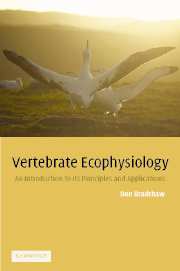Book contents
- Frontmatter
- Contents
- Introduction
- 1 Homeostasis: a fundamental organising paradigm in ecophysiology
- 2 Stress: the concept and the reality
- 3 Basic methods used in ecophysiological studies
- 4 Turnover methodology: theory and practice
- 5 Case studies of stress: incidence and intensity
- 6 Survival in deserts
- 7 Torpor and hibernation in cold climates
- 8 Marine birds and mammals
- 9 Conclusion
- Appendix 1 Population estimation methods
- Appendix 2 Estimation of food intake in Tiliqua rugosa
- Appendix 3 Simultaneous measurement of sodium and potassium concentration in plasma or urine using the IL 143 digital flame photometer
- Appendix 4 Determination of plasma urea nitrogen
- Appendix 5 Radioimmunoassay of testosterone in plasma
- Appendix 6 Preparation of ‘stripped plasma’
- Appendix 7 Radioimmunoassay of testosterone in faeces
- Appendix 8 The comparative method
- Appendix 9 Basic turnover equations
- References
- Index
7 - Torpor and hibernation in cold climates
Published online by Cambridge University Press: 05 June 2012
- Frontmatter
- Contents
- Introduction
- 1 Homeostasis: a fundamental organising paradigm in ecophysiology
- 2 Stress: the concept and the reality
- 3 Basic methods used in ecophysiological studies
- 4 Turnover methodology: theory and practice
- 5 Case studies of stress: incidence and intensity
- 6 Survival in deserts
- 7 Torpor and hibernation in cold climates
- 8 Marine birds and mammals
- 9 Conclusion
- Appendix 1 Population estimation methods
- Appendix 2 Estimation of food intake in Tiliqua rugosa
- Appendix 3 Simultaneous measurement of sodium and potassium concentration in plasma or urine using the IL 143 digital flame photometer
- Appendix 4 Determination of plasma urea nitrogen
- Appendix 5 Radioimmunoassay of testosterone in plasma
- Appendix 6 Preparation of ‘stripped plasma’
- Appendix 7 Radioimmunoassay of testosterone in faeces
- Appendix 8 The comparative method
- Appendix 9 Basic turnover equations
- References
- Index
Summary
Endothermic thermoregulation
The ability of endotherms to reduce significantly their body temperature during periods of intense cold or low food availability would seem to be an eminent adaptation for vertebrates that have high basal rates of metabolism. Unlike ectotherms, endotherms elevate their body temperature above that of their surroundings by the constant oxidation of foodstuffs and the heat produced from this process (i.e. resulting from the thermodynamic inefficiency of the various biochemical pathways, otherwise known as ‘futile’ proton cycling) is not wasted, but used to raise the body temperature of the animal (see Brand et al., 1991; Rolfe and Brand, 1997). This is in contrast to ectothermic vertebrates such as reptiles and amphibians, which use external sources of heat, such as the sun, to elevate and maintain a constant body temperature while active.
As a consequence of this difference in sources of heat production, ectotherms are more productive than endotherms, with much higher efficiencies of biomass conversion. Pough (1983) calculated that 16 species of small birds and mammals converted only 1.4% of the energy they assimilated into biomass, compared with an average conversion efficiency of 46.3% for eight species of amphibian and reptile. Thus, despite their low rates of energy flow, ectotherms are of great importance in terrestrial ecosystems because of their high conversion efficiencies and the energy they make available to other organisms.
- Type
- Chapter
- Information
- Vertebrate EcophysiologyAn Introduction to its Principles and Applications, pp. 166 - 174Publisher: Cambridge University PressPrint publication year: 2003



